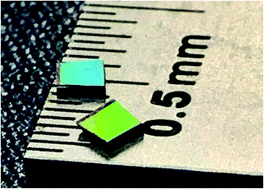Bio-inspired gas sensing: boosting performance with sensor optimization guided by “machine learning”
Abstract
The performance of existing gas sensors often degrades in field conditions because of the loss of measurement accuracy in the presence of interferences. Thus, new sensing approaches are required with improved sensor selectivity. We are developing a new generation of gas sensors, known as multivariable sensors, that have several independent responses for multi-gas detection with a single sensor. In this study, we analyze the capabilities of natural and fabricated photonic three-dimensional (3-D) nanostructures as sensors for the detection of different gaseous species, such as vapors and non-condensable gases. We employed bare Morpho butterfly wing scales to control their gas selectivity with different illumination angles. Next, we chemically functionalized Morpho butterfly wing scales with a fluorinated silane to boost the response of these nanostructures to the vapors of interest and to suppress the response to ambient humidity. Further, we followed our previously developed design rules for sensing nanostructures and fabricated bioinspired inorganic 3-D nanostructures to achieve functionality beyond natural Morpho scales. These fabricated nanostructures have embedded catalytically active gold nanoparticles to operate at high temperatures of ≈300 °C for the detection of gases for solid oxide fuel cell (SOFC) applications. Our performance advances in the detection of multiple gaseous species with specific nanostructure designs were achieved by coupling the spectral responses of these nanostructures with machine learning (a.k.a. multivariate analysis, chemometrics) tools. Our newly acquired knowledge from studies of these natural and fabricated inorganic nanostructures coupled with machine learning data analytics allowed us to advance our design rules for sensing nanostructures toward the required gas selectivity for numerous gas monitoring scenarios at room and high temperatures for industrial, environmental, and other applications.

- This article is part of the themed collection: Biological and bio-inspired optics


 Please wait while we load your content...
Please wait while we load your content...
